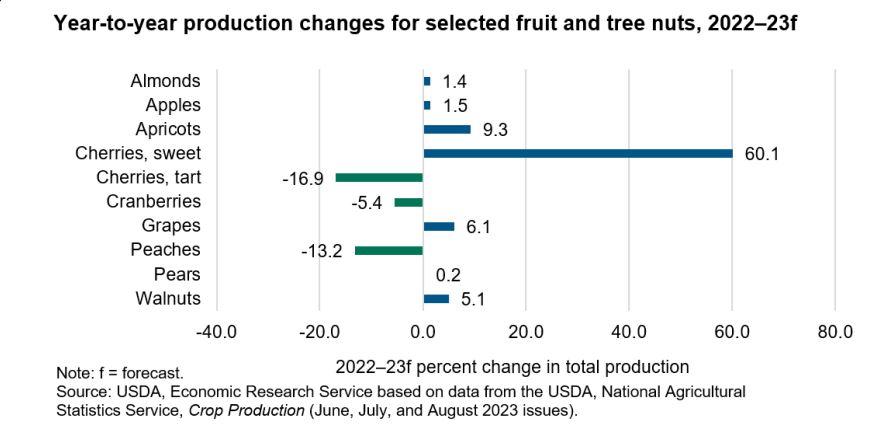The price index for fruit and tree nuts was up 9 percent from June 2023 and 11 percent from July 2022, reports USDA’s National Agriculture Statistics Service (NASS).
“Price increases during July for apples, grapes, peaches, pears, and strawberries more than offset price decreases for fresh and processed oranges compared to a year ago,” says the report.
Overall, consumer price increases in August were up only 0.6 percent from the previous August.
NASS forecast almond, apple, apricot, grape, pear, sweet cherry, and walnut production to be up for 2023-24, while peach, tart cherry, and cranberry production are expected to decrease.
Production increases were startlingly high for fresh cherries: up 60 percent from the previous year, while grape production was up 6 percent.
Apricot production rose by 9 percent, benefiting from heavy blooms, adequate chill hours, and rain. Nevertheless, “the U.S. apricot industry has experienced a long-term downward trend in bearing acreage (down 62 percent over the past 20 years),” reports NASS. “The downward trend in production has coincided with a decrease in the share of apricots utilized for the processed market.”
Indeed, the share of apricot production for the fresh market has exceeded that for the processed market since 2018, a trend that appears likely to continue.
As for citrus, “final estimates for the 2022-23 citrus season show U.S. citrus production reaching 4.9 million tons, down 12 percent from 2021-22. This marks the lowest combined production levels of U.S. citrus in at least 50 years. This historically small crop is mostly due to declining Florida production of oranges.”
The drop in Florida orange juice production for 2022-23 resulted in a first for the U.S. citrus industry: a record share is going to the fresh as opposed to the processed market: 63 percent versus 37 percent, whereas the mix was 50-50 in 2021-22. Drops in Florida production are attributed to huanglongbing disease (HLB or citrus greening) as well as severe hurricane shocks over recent years.
Even so, “U.S. citrus production for the fresh market reached 3 million tons in 2022-23, up 10 percent from the previous season, with larger fresh-market crops of oranges (up 2 percent), grapefruit (up 5 percent), lemons (up 8 percent), and tangerines (up 29 percent).”
Apples: For the 2023-24 season (August-July) U.S. total apple production is forecast at “9.9 billion pounds, up 1.5 percent from a year ago. In Washington, the largest producing state, the crop is forecast to be 6.7 billion pounds, up 9 percent from last year. While Washington’s 2023-24 apple crop was not affected by spring freeze events like last season, the current forecast is still lower than volumes recorded in 2019-21. The Washington State Tree Fruit Association described fruit quality as excellent and estimates organic apples will account for 15.7 percent of the State’s production this season.”
By contrast, 30 percent of apples in New York state were in “very poor or poor condition” in September.
Nevertheless, fresh apple exports dropped in 2022-23 from the level of the previous year. In June 2023, India announced that it would drop retaliatory tariffs imposed on U.S. apples in 2023. “While industry reports note that the welcomed tariff removal comes ahead of the fall apple harvest in the United States, U.S. fresh apple exports will need to compete with India’s current top suppliers, which include Turkey, Italy, and Iran.”
Tropical fruits: for over the last 50 years, “the United States has been the top importer of bananas by volume annually. The United States has been the top importer by volume since 1975 for fresh mangoes and since 1997 for fresh pineapples. U.S. imports of tropical fruit typically come from Mexico, Central America, and South America. . . . Since 2007, following the implementation of the Dominican Republic-Central America-United States Free Trade Agreement (CAFTA-DR), most banana imports have come from Guatemala.”
Banana availability has been relatively flat (at around 25 pounds per capita) over recent years, while per capita availability of mangoes and pineapples has shot up.



